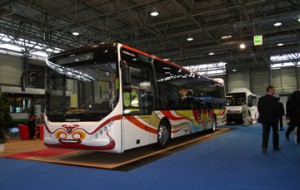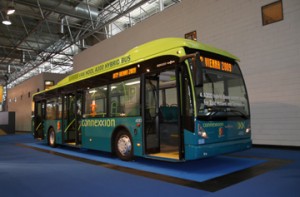By Doug Jack
Every two years the 124-year-old International Union of Public Transport (UITP) holds a major Conference and Exhibition, and staged its 58th event in June in Vienna, Austria.
The capital of Austria is a fascinating city with a long and colorful history, and is the only city in Europe with a million-plus population in which more people travel by public transport than by car, with a highly efficient network of metro, tram and bus services.
The UITP Exhibition is all about quality of visitors rather than quantity, welcoming many senior executives in the global operating industry. Most manufacturers displayed only one vehicle, but report strong sales of transit buses and interurban coaches in most markets. However, they say sales of top-end luxury coaches are suffering partly because of a downturn in extended tours, and also because customers are having difficulties in obtaining finance.
Get more great articles like this one with a subscription to BusRide!
Click here to subscribe.
This year the manufacturers launched several advanced and interesting vehicles. Six years ago at UITP Madrid, Mercedes-Benz introduced the first of 36 fuel cell buses that subsequently entered extended trials with ten European cities, plus Beijing and Perth, Australia.
In Vienna, Mercedes-Benz launched the next generation, the 40-ft Citaro FuelCELL-Hybrid bus, with the floor only one step above the ground from front to rear. Each of the 396 individual fuel cells fit into a tower at the rear of the bus and operate independently. Compared with the first generation, Mercedes-Benz believes this vehicle extends the service life 50 percent to at least six years, and operating efficiency as much as 58 percent. Heat exchangers on the rear of the stacks can warm the passenger compartment; otherwise four fans extract the heat from the bus.
The first generation had nine gas tanks mounted at the front of the roof and concealed by a stylish fairing. The new generation is more efficient with seven tanks. The power-steering pump, air-conditioning and air compressor operate electrically on an on-demand basis, for optimum efficiency.
The space that normally houses an automatic gearbox on a diesel bus now accommodates two DC/AC converters that pass current to electric motors in each of the hubs of the portal rear axle. With a continuous output of 120kW and a peak output of 160kW, these motors can cope with the most demanding conditions such as restarting on steep gradients. Electric current regenerates during braking, which helps the FuelCELL-Hybrid bus achieve hydrogen savings of 10-25 percent, depending on traffic conditions and topography.
Clever design and engineering reduces the weight of the latest generation by around one ton, giving the bus greater passenger carrying capacity.
Mercedes-Benz has also developed diesel hybrid buses. The cities of Rotterdam and Hamburg are due to take delivery of two each before the end of this year. The electric drivetrain is the same as on the FuelCELL-Hybrid bus.
MAN and Scania have taken a different approach to the storage of electrical energy, compared with the other European manufacturers. Both have opted for super-capacitors, which are lighter than batteries and can hold sufficient energy for a bus to accelerate solely on electric power, silently and without any emissions. They are very good at delivering short bursts of energy, time after time, and should last the lifetime of the bus.
MAN has a compact 4.58-liter diesel engine to power a generator and uses an automated six-speed manual transmission, with software adapted to hybrid use. A stylish brushed steel C pillar distinguishes the body structure.
Scania has no engine in its range smaller than 9 liters, but that unit can run on diesel, compressed natural gas or ethanol. Scania has promoted ethanol for several years, and showed one of six tri-axle low-entry buses that are going into service in Stockholm on a two-year extended trial. Available in Sweden as a by-product of the timber industry, the country taxes ethanol at a lower rate than diesel. Scania believes ethanol engines will reduce fuel consumption by 25 percent and carbon dioxide emissions by up to 90 percent.
Volvo has developed its ISAM hybrid drive system in use on Hybrid Volvo buses now running in London and Gothenburg, with orders taken from Luxembourg and Swiss Post.
Van Hool holds orders for more hybrid buses than any other European builder. De Lijn, the principal bus company in the Flemish part of Belgium, increased an order for 35 hybrid buses by a further 44 units. Van Hool also displayed a hybrid bus for the Dutch Connexxion fleet.
Last year, Temsa Global launched its Avenue range of city buses, available with either a full low-floor or a low-floor entry layout, and will soon go into volume production. Temsa says it offers an optional CNG-fueled model, which it launched in Vienna. The company says this was a logical development as several Turkish cities placed large orders for gas-fueled buses.
The innovative Polish manufacturer Solaris has delivered hybrid articulated buses all using a Cummins-Allison driveline to a number of customers. The first generation had a larger Cummins engine mounted on the offside in the front section of the vehicle. Following practical experience, Solaris now uses a smaller Cummins engine coupled to the Allison transmission in the trailer section. Solaris says its next development would be a standard two-axle city bus with a hybrid driveline.
The Czech Republic has had a long tradition of building buses. The largest manufacturer, Iveco-Irisbus, did not attend the exhibition, but two other builders were present. Sor started making buses shortly after the Czech Republic became independent, and showed one of its 40-ft low-floor buses. The city of Prague has ordered 620 of the vehicles for delivery over a five-year period.
Another Czech company, Tedom, is building relatively small numbers of stylish low-floor city buses, mostly with CNG-fueled engines.
Trolleybuses remain popular in Italy, Switzerland and several countries in Central and Eastern Europe, including Russia.
The fact that they are emission-free has become an important selling point in recent years.
Do you like this article? Subscribe TODAY to get
BusRide now available in digital!
The city of Minsk, the capital of Belarus that lies between Poland and Russia, has a long tradition of building commercial vehicles. Belkommunmash makes around 600 trolleybuses per annum and showed a new low-floor model. The driver sat centrally in a compartment above the front axle.
Hungary has a long tradition of bus building, but sadly, Ikarus is no more. The southern city of Szeged has an extensive trolleybus network and has been converting and building its own models. They showed a full low-floor articulated trolleybus and said that orders could be taken from other cities, after an extensive proving program Hess of Switzerland builds two and three section trolleybuses that incorporate an aluminum structural system. I later saw the 80-ft three-section vehicles in Zurich running on morning peak services carrying large numbers of passengers. Despite the overall length, they look remarkably maneuverable.
Only one Chinese manufacturer brought a vehicle to Vienna, but others showed small shell units. Youngman displayed a low-floor city bus with a complete set of European mechanical components. The company claims it can build a city bus to European standards with a price savings of 25 percent.
I still believe Europe represents a major challenge for Chinese builders. We account for around 10 to 12 percent of global annual registrations, yet are among the most demanding regions in terms of parts and service support.
Dubai will host the next major UITP Congress and Exhibition in June 2011.
Doug Jack is with Transport Resources in the United Kingdom.



